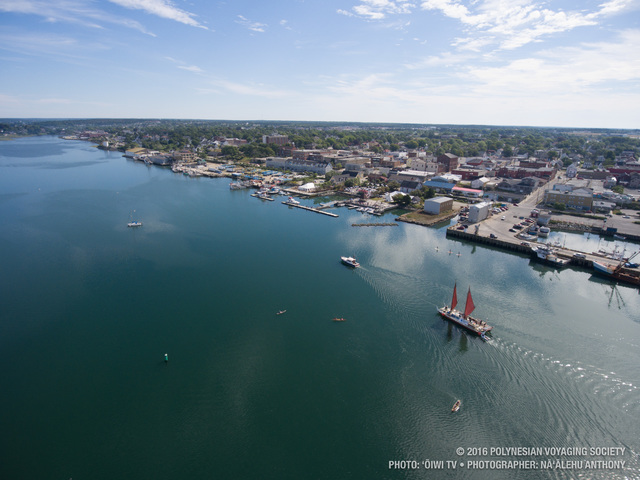Mi’kmaw Nation greets Hokule‘a in Nova Scotia

COURTESY POLYNESIAN VOYAGING SOCIETY / OIWI TV
The Hokule‘a took its Malama Honua Worldwide Voyage north of the United States, arriving at Canada’s Port of Yarmouth early Sunday morning.
The Hokule‘a made landfall Sunday in Nova Scotia on its trek around the world.
It was the canoe’s first stop in Canada in more than two decades. The canoe’s last visit was in 1995 when it reached Vancouver, British Columbia.
Local leaders and community members welcomed the crew in Yarmouth, Nova Scotia, early Sunday morning, including Yarmouth Mayor Pam Mood, according to a release from the Polynesian Voyaging Society.
Mi’kmaw Nation members attended in traditional garb and performed cultural dances and rhythmic drumming. A Mi’kmaw representative presented feathers to each Hokule‘a crew member as a symbol of peace and unity.
“This makes me believe that we’re more alike than we’re different,” said Nainoa Thompson, master navigator and voyaging society president, during the arrival ceremony. “When we come here and you tell us to come to your place, and thank us for being here, and for being happy — that’s aloha.”
Chief Deborah Robinson of the Acadia First Nations, which encompasses five Mi’kmaw reserves, said, “The preservation of our environment and conservation of the resource is of utmost importance to us as the Mi’kmaw. We all have the same goal, in ensuring a future for our children, and for children for generations to come.”
Don't miss out on what's happening!
Stay in touch with breaking news, as it happens, conveniently in your email inbox. It's FREE!
The Mi’kmaw are one group within the Wabanaki Confederacy in the eastern region of North America.
Before arriving in Canada, the crew spent about a week in Maine, visiting with other members of the Wabanaki Confederacy.
Crew member Maya Saffery said in a blog post that the crew called out in Hawaiian to ask permission of the Wabanaki to disembark in Mount Desert, Maine, and come ashore. She said the crew was invited to Indian Island, a reservation for the Penobscot Nation, which is part of the confederacy, and there she witnessed moving acts of “aloha aina,” or love of the land.
“They created an environment for their children where they can grow up being proud of being Penobscot and expressing that identity through song and dance,” she wrote. “By simply drumming, singing and dancing together, they were proclaiming as Wabanaki without hesitation that they, the people of the dawn, are not only surviving, but thriving.”
The canoe will stay in Nova Scotia for about six days.
The Hokule‘a is on a journey around the globe for its Malama Honua Worldwide Voyage and projects finishing its roughly four-year tour in June.
After visiting Canada, the crew will sail back to New York and up the Hudson River. From there the crew is looking at sailing to Lake Erie, Lake Ontario and possibly up the St. Lawrence River to Montreal. The Hokule‘a will return to Hawaii via the Panama Canal.
6 responses to “Mi’kmaw Nation greets Hokule‘a in Nova Scotia”
Leave a Reply
You must be logged in to post a comment.




The still surviving part, of the 1970s Hawaiian Renaissance, that has kept Hawaiian history & culture alive, throughout the world.
Many nations, probably knew very little about Hawaii, until the Hokulea showed up on their shorelines.
UH Professor Dr. Ben Finney’s dream, United many Hawaiians, and gave the Hawaiian Renaissance a great push foreword.
agree..very proud of Nainoa and all those who made this voyage of peace and cultural understanding possible. It is Hawaii at its best.
Don’t you mean Mi’kmaq? Mi’kmaw is singular.
Dr. Ben Finney, Tommy Holmes, Herb Kane- history needs to be reminded how it all came to be.
I love Herb Kane’s cultural books. He writes so well. What a gentleman. Mainland educated, a proud American and a proud Hawaiian. A gem.
“Ancestry can be a proxy for race. It is that proxy here”. Rice v Cayetano, US Supreme Court. The court was referring to the Hawaiian law construct as follows: “Hawaiian and native Hawaiian”. The Hokulea project is a Hawaiian project, not a native Hawaiian project. One never hears any support for native Hawaiians coming from Hawaiians. Why is that? The Hawaiian Renn is superfluous in relation to standard federal Native American law, which was obstructed by Hawaii in favor of royalism.